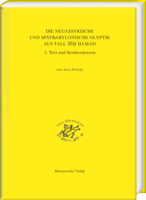|
weitere Titel zum Thema:
Download:
In den Ausgrabungsabschnitten „Nordost Ecke der Unterstadt II“ und „Mittlere Unterstadt II“ wurden zwischen 1978 und 2008 über 1500 glyptische Funde mit über 500 verschiedenen Siegelbildern ausgegraben. Das hier vorgelegte Corpus besteht aus 55 Siegel, 176 gesiegelte Texte, 1226 Tonsicherungen, 61 s.g. Langetten (Ergänzungen sind in A. Fügert et al. 2014, Early Neo-Assyrian Dūr-Katlimmu. Proceedings of the 8th ICAANE Vol.I, 217-239 publiziert). Die Objekte sind in die erdbefundorientierte durchlaufende stratigrafische Sequenz des Grabungsabschnitts „Mittlere Unterstadt II“ eingebunden, die von der frühen neuassyrischen Zeit (10./9. Jahrhundert v.Chr.) über den Fall des Neuassyrischen Reiches (612 v.Chr.) bis zum spätbabylonischen Reich (626-539 v.Chr.) und darüber hinaus reicht. In der Zeit bis zur Mitte des 6. Jahrhunderts v.Chr. durchlief die Stadt Dūr-Katlimmu drei Vollbesiedlungsphasen; danach wurden einige Gebäudeteile der Unterstadt II bis zur vollständigen Auflassung nachgenutzt. Da einige Gebäude über den Fall des Assyrischen Reiches hinweg durchgehend bewohnt waren, ist die seltene Möglichkeit gegeben die Auswirkungen dieses tiefgreifenden politischen Einschnitts auf das glyptische Material zu untersuchen. Ferner ist im Laufe der Analyse deutlich geworden, dass die Glyptik – ergänzend zu den Schriftquellen – wesentlich zur Aufklärung der sozialen Struktur der Unterstadt II beiträgt.
Auf der Grundlage der stratigraphischen Analyse werden die Ablagerungskontexte der glyptischen Funde in drei Kategorien eingeteilt: (I) gehörig zu Original-Inventar, (II) sekundär abgelagert und (III) umgelagert (Kap. 3). In einigen Fällen war es möglich die Verwendung von Siegeln bestimmten Bereichen oder sogar einzelnen Räumen zuzuordnen. Die u.a. daraus abzuleitende Feststellung, dass private Haushalte in der Unterstadt II Siegel für die Güterverwaltung verwendeten, ist ein wesentlicher Beitrag zum Forschungsstand (Kap. 4). Anstelle der bisherigen Datierung der Neuassyrischen Glyptik mit Hilfe von Stilgruppen werden die Bildthemen in den Vordergrund gestellt (Kap. 5); in so genannte Gestaltungsgruppen lässt sich der stilistische Pluralismus besser abbilden. Die Zusammenschau des glyptischen Corpus der drei Vollbesiedelungsphasen der Unterstadt II (Kap. 6) führt zu der Aussage, dass Mitglieder der assyrischen Elite diese bewohnten. Als Nachweis wird für die erste Vollbesiedlungsphase der Abdruck von sog. Beamtensiegeln auf Langetten herangezogen, da diese für den Transport über weite Strecken ungeeignet sind; zusätzlich spricht die Praxis des Gegensiegelns dafür. Einzigartig ist der Nachweis der Verwendung von Schmuckstücken als Siegelersatz. Entgegen der bisherigen Meinung, dass Stempelsiegel ab der zweiten Hälfte des achten Jahrhunderts v.Chr. zunehmend verwendet wurden beweisen zahlreiche Belege, dass die Wiedereinführung des Stempelsiegels schon im 9. Jahrhundert v.Chr. anzusetzen ist. Der glyptische Befund der zweiten Vollbesiedelungsphase besteht hauptsächlich aus entsorgten und zum Teil umgelagerten Objekten, was auf Bauaktivitäten zurückzuführen ist. Die dritte Vollbesiedelungsphase wird von dem „Roten Haus“ dominiert (vgl. BATSH 11). Die Verteilung glyptischer Funde darin lässt Bereiche für Zuständigkeiten und Lagerhaltung erkennen. Die Praxis des Gegensiegelns beweist die kontinuierliche Anwesenheit von Akteuren für die Güterverwaltung. Erstmals kann die Aufbewahrung unbrauchbar gemachter Tonsicherungen, die bisher aus der Verwaltung zentralassyrischer Paläste bekannt war, für einen privaten Haushalt belegt werden. Die politische Zäsur des Zusammenbruchs des Neuassyrischen Reiches wird von dem glyptischen Befund im Roten Haus nicht widergespiegelt; eine Wende in der Siegelnutzung für die regelhafte Güterverwaltung folgt erst auf die Brandzerstörung des Roten Hauses um die Mitte des sechsten Jahrhunderts v.Chr. Die Inschrift auf dem Siegelbild Nr. 128 konnte nachträglich als proto-arabisch erkannt werden, vgl. B. Sass, N.A.B.U. 2015/3, 80. More than 1500 glyptic finds with more than 500 motifs have been excavated in the excavation units “Northeast Corner” and “Central” Lower Town II between 1978 and 2008. The here presented corpus consist of 55 seals, 176 sealed written artefacts, 1226 sealings, and 61 so called langettes (additions are published in A. Fügert et al. 2014, Early Neo-Assyrian Dūr-Katlimmu. Proceedings of the 8th ICAANE Vol.I, 217-239). They are embedded in the debris-defined continuous stratigraphic sequence of the excavation unit “Central Lower Town II” that extends from the foundation of the Lower Town II on bedrock in the early Neo-Assyrian period (10th/9th century BC) via the fall of the Neo-Assyrian empire (612 BC) to the Late Babylonian empire (626-539 BC) and beyond. During this time, the city of Dūr-Katlimmu passed through three phases of full occupation until the middle of the 6th century BC; thereafter until its complete discontinuation, intact parts of the buildings of the Lower Town II were reused. The fact that some buildings in the Lower Town II were continuously inhabited from the Neo-Assyrian into the Late Babylonian period provided a rare potential to examine the reflections of political changes in the glyptic material of the site. Also, analyzing the glyptic record turned out to be essential for characterizing the social structure of the Lower Town II in addition to the textual sources. Based on the stratigraphic analyses the context of the glyptic finds is separated in three categories, as belonging to the original inventory (I), secondarily deposited (II), and relocated (III). In some cases, it was possible to relate their use to certain areas or even rooms within the household. Resulting in a major contribution to the state of research is the statement that private households in the Lower Town II used seals within the administration of commodities (chap. 4). Rejecting the possibility to date Neo-Assyrian glyptic on the basis of styles the glyptic imagery of the seals is examined by subjects or design groups (chap. 5). Presenting the results (chap. 6) the glyptic corpus of the three phases of full occupation reveals that members of the Assyrian elite dwelled in the Lower Town II. In the context of the first full occupation phase this is proven by the occurrence of impressions of the well-known group of ‘official seals’ on langettes that are generally not suited for long distance transport and by the practice of counter-sealing. The unique practice of using jewelry as seal substitutes also points to the presence of the upper class. Furthermore, considerable quantities of stamp seals prove that the use of them has to be predated to the ninth century BC – hitherto commonly dated to the second half of the eighth century BC. Due to building activities the glyptic record of the second full occupation phase consists of discarded and partly relocated sealings outside the households inhabited at the time. The third full occupation phase of the Lower Town II is dominated by the ‘Red House’ (cf. BATSH 11). The distribution of glyptic finds within it reflected clearly areas of responsibility and of storage. Counter-sealing proves the continuous presence of administrative actors for its commodities. The practice of keeping broken sealings, previously observed only in the palaces of Central Assyria, is now attested for the Red House. Inhabited before and after the fall of Assyria the glyptic corpus hardly mirrors this political caesura; the actual break with respect to seal use follows the destruction of the Red House around the middle of the sixth century BC. The inscription on seal image no. 128 was recognized ex post as Proto-Arabic, cf. B. Sass, N.A.B.U. 2015/3, 80. |






